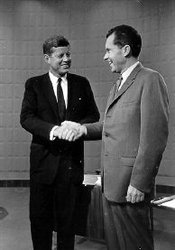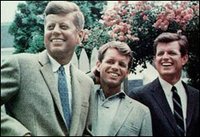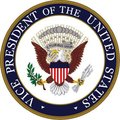John F. Kennedy
|
|
| ||
| Order: | 35th President | |
| Vice President: | Lyndon B. Johnson | |
| Term of office: | January 20, 1961 – November 22, 1963 | |
| Preceded by: | Dwight D. Eisenhower | |
| Succeeded by: | Lyndon B. Johnson | |
| Date of birth: | May 29, 1917 | |
| Place of birth: | Brookline, Massachusetts | |
| Date of death: | November 22, 1963 | |
| Place of death: | Dallas, Texas | |
| First Lady: | Jacqueline Lee Bouvier Kennedy | |
| Political party: | Democratic | |
John Fitzgerald Kennedy (May 29, 1917 – November 22, 1963), often referred to as Jack Kennedy or JFK, was the 35th President of the United States (1961–1963). The events surrounding his assassination on November 22, 1963 are remembered in vivid detail by nearly all Americans that lived through them, and also by many others. Mourned around the world, presidents, prime ministers, and members of royalty walked behind the casket at his funeral.
The youngest person ever to be elected president of the U.S. (Theodore Roosevelt was the youngest ever to serve as president), Kennedy was also the youngest ever to die. As of 2005, he was also the only Catholic ever to be elected president, the last Democratic Party candidate from the North to be elected president, and the last president to die in office. He was also the first person to become president born in the 20th century.
Major events during his presidency included the Cuban Missile Crisis, the building of the Berlin Wall, the Space Race, early events of the Vietnam War, and the Civil Rights Movement. He is rated fairly high in many surveys that rank presidents, but his agenda was still incomplete at his death — with most of his civil rights policies coming to fruition through his successor, Lyndon B. Johnson.
| Contents |
Early life and education
Kennedy was born in Brookline, Massachusetts, the son of Joseph P. Kennedy, Sr. and Rose Fitzgerald. As a young man he attended The Choate School, a boarding school in Wallingford, Connecticut. Before enrolling in college, he attended the London School of Economics for a year, studying political economy. In the fall of 1935, he enrolled in Princeton University, but was forced to leave during Christmas break after contracting jaundice. The next fall, he began attending Harvard University. Kennedy traveled to Europe twice during his years at Harvard, visiting the United Kingdom, while his father was serving as ambassador to that country. In 1937, Kennedy was erroneously prescribed steroids to control his colitis, which only heightened his medical problems causing him to develop osteoporosis of the lower lumbar spine [1] (http://www.npr.org/templates/story/story.php?storyId=1276266).
In 1938, Kennedy wrote his honors thesis on the British portion of the Munich Agreement. He was an average student at Harvard, never earning an A, but mostly B's and C's, with a single D in a sophomore history course. He graduated cum laude from Harvard with a degree in international affairs in June 1940. His thesis, entitled Why England Slept, was published in 1940 and, with the aid of his affluent and powerful father, it became a best-seller.
Military service
In the spring of 1941, Kennedy volunteered for the U.S. Army, but was rejected, mainly because of his troublesome back. However, the U.S. Navy accepted him in September of that year. He participated in various commands in the Pacific Theater and earned the rank of lieutenant, commanding a patrol torpedo boat or PT boat.
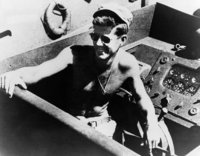
On August 2, 1943, Kennedy's boat, the PT-109, was taking part in a night-time military raid near New Georgia (near the Solomon Islands) when it was rammed by a Japanese destroyer. Kennedy was thrown across the deck, injuring his already troubled back. Still, Kennedy somehow towed a wounded man three miles through the ocean, arriving on an island where his crew was subsequently rescued. Kennedy said that he blacked out for periods of time during the ordeal. For these actions, Kennedy received the Navy and Marine Corps Medal under the following citation
- "For heroism the rescue of 3 men following the ramming and sinking of his motor torpedo boat while attempting a torpedo attack on a Japanese destroyer in the Solomon Islands area on the night of Aug 1-2, 1943. Lt. KENNEDY, Capt. of the boat, directed the rescue of the crew and personally rescued 3 men, one of whom was seriously injured. During the following 6 days, he succeeded in getting his crew ashore, and after swimming many hours attempting to secure aid and food, finally effected the rescue of the men. His courage, endurance and excellent leadership contributed to the saving of several lives and was in keeping with the highest traditions of the United States Naval Service."
Kennedy's other decorations of the Second World War include the Purple Heart, Asiatic-Pacific Campaign Medal, and the World War II Victory Medal. He was honorably discharged in early 1945, just a few months before the Japanese surrendered.
In May 2002 a National Geographic expedition found what is believed to be the wreckage of the PT-109 in the Solomon Islands [2] (http://news.nationalgeographic.com/news/2002/07/0709_020710_kennedyPT109.html).
Early political career
After World War II, Kennedy entered politics (partly to fill the void of his popular brother, Joseph P. Kennedy, Jr., on whom his family had pinned many of their hopes but who was killed in the war). In 1946, Representative James Michael Curley vacated his seat in an overwhelmingly Democratic district to become mayor of Boston and Kennedy ran for that seat, beating his Republican opponent by a large margin. He was reelected two times, but had a mixed voting record, often diverging from President Harry S. Truman and the rest of the Democratic Party.
Persistent rumors have suggested that Kennedy married Durie Malcolm briefly in early 1947. Their romance was mentioned in the January 20, 1947 issue of The New York World-Telegram, but no conclusive proof of a marriage has been found. Beyond a flat denial, Durie declined to discuss the alleged marriage. Seymour Hersh's The Dark Side of Camelot devotes a chapter to the alleged marriage; he interviewed several of Kennedy's friends who reported the marriage as fact, and additionally noted that Joseph P. Kennedy managed to cover-up the fling, fearing that his son's marriage to a divorcee would harm his nascent political career. The marriage rumors were little-known until 1961, when rumors began to circulate in Washington, D.C. [3] (http://www.thesmokinggun.com/jfk/durie1.html)

In 1952, Kennedy ran for the Senate with the slogan "Kennedy will do more for Massachusetts." In an upset victory, he defeated Republican incumbent Henry Cabot Lodge, Jr. by a margin of about 70,000 votes. Kennedy adroitly dodged criticizing fellow Senator Joseph McCarthy's controversial campaign to root out Communists and Soviet spies in the U.S. government, because of McCarthy's popularity in Massachusetts. McCarthy was a friend of Kennedy, Kennedy's father, dated the Kennedy sisters, and younger brother Robert F. Kennedy briefly worked for McCarthy. Although Kennedy was ill during the 65–22 vote to censure McCarthy, he was criticized by McCarthy opponents such as Eleanor Roosevelt who later said of the episode "he should have displayed less profile, and more courage".
Kennedy married Jacqueline Bouvier on September 12, 1953. He underwent several spinal operations in the two following years, nearly dying (receiving the Catholic religion's "last rites" four times during his life), and was often absent from the Senate. During this period, he published Profiles in Courage, highlighting eight instances in which U.S. Senators risked their careers by standing by their personal beliefs. The book was awarded the 1957 Pulitzer Prize for Biography.
In 1956, Kennedy campaigned for the Vice Presidential nomination at the Democratic National Convention, but convention delegates selected Tennessee senator Estes Kefauver instead. However, Kennedy's efforts helped bolster the young Senator's reputation within the party.
An example of Kennedy's political suppleness, prior to the 1960 campaign, was his handling of the Civil Rights Act of 1957. He voted for final passage, while earlier voting for the "jury trial amendment", which rendered the Act toothless. He was able to say to both sides that he supported them.
1960 Presidential election
In 1960, Kennedy declared his intent to run for President of the United States. In the Democratic primary election, he faced challenges from Senator Hubert H. Humphrey of Minnesota, Senator Lyndon B. Johnson of Texas, and Adlai Stevenson, the Democratic nominee in 1952 and 1956 who was not officially running but was a favorite write-in candidate. Kennedy won key primaries like Wisconsin and West Virginia and landed the nomination at the Democratic National Convention in 1960.
On July 13, 1960 the Democratic Party nominated Kennedy as its candidate for president. Kennedy asked Johnson to be his Vice Presidential candidate, despite clashes between the two during the primary elections. Somewhat to Kennedy's staff's dismay, Johnson accepted. Some theorists have speculated that Johnson had blackmailed Kennedy by threatening to expose Kennedy's physical ailments and/or affairs, but LBJ could also deliver votes from the South. Another possibility is that Kennedy wanted to remove Johnson from the Senate Majority Leader position so that United States Senate Majority Whip Mike Mansfield would assume the leadership, as Kennedy considered Mansfield easier to work with than Johnson.
Issues in the election included how to deal with the nation's poor, the economy, JFK's Catholicism, Cuba, and whether or not both the Soviet space and missile programs had surpassed those of the USA.
In September and October, Kennedy debated Republican candidate Vice President Richard Nixon in the first ever televised presidential debates. During the debates, Nixon looked tense, sweaty, and unshaven contrasted to Kennedy's composure and handsomeness, leading many to deem Kennedy the winner, although historians consider the two evenly matched as orators. Interestingly, many who listened on radio thought Nixon more impressive in the debate.[4] (http://www.museum.tv/archives/etv/K/htmlK/kennedy-nixon/kennedy-nixon.htm) The debates are considered a political landmark: the point at which the medium of television played an important role in politics and looking presentable on camera became one of the important considerations for presidential and other political candidates.
In the general election on November 8 1960, Kennedy beat Nixon in a very close race. There were serious allegations that vote fraud in Texas and Illinois had cost Nixon the presidency[5] (http://www.leanleft.com/archives/cat_reviews.html). Especially troubling were the unusually huge margins in Richard Daley's Chicago — which were announced after the rest of the vote in Illinois. The only change after the official recount was a win for Kennedy in Hawaii.
Presidency

John F. Kennedy was sworn in as the 35th President on January 20, 1961. In his inaugural address he spoke of the need for all Americans to be active citizens. "Ask not what your country can do for you, ask what you can do for your country", he said. He also asked the nations of the world to join together to fight what he called the "common enemies of man... tyranny, poverty, disease, and war itself".
Foreign policies
On April 17, 1961, the Kennedy administration implemented a modified version of Kennedy predecessor Dwight D. Eisenhower's plan to depose Fidel Castro, the communist leader of Cuba. With support from the CIA, in what is known as the Bay of Pigs Invasion, 1,500 Cuban exiles returned to the island to depose Castro, but the CIA had overestimated popular resistance to Castro and the exiles did not rally the Cuban people as expected. By April 19, Castro's government had killed or captured most of the exiles and Kennedy was forced to negotiate for the release of 1,189 of them. After 20 months, Cuba released the exiles in exchange for $53 million in food and medicine. The incident was a major embarrassment for Kennedy, but he took full responsibility for the debacle (See Bay of Pigs Invasion for more information).
On August 13, 1961, the East German government began construction of the Berlin Wall separating East Berlin from the Western sector of the city, due to the American military presence in West Berlin. Some claimed this action was in violation of the "Four Powers" agreements. Kennedy initiated no action to have it dismantled, and did little to reverse or halt the eventual extension of this barrier to a length of 155 km.
The Cuban Missile Crisis began on October 14, 1962 when American U-2 spy planes took photographs of the construction site of a Soviet nuclear missile site in Cuba. Kennedy faced a dire dilemma: if the U.S. attacked the sites it would likely have led to nuclear war with Russia. If the U.S. did nothing, it would endure the perpetual threat of tactical nuclear weapons within its region, in such close proximity, that if launched pre-emptively, the U.S. may have been unable to retaliate. Another fear was that the U.S. would appear to the world as weak. Many military officials and cabinet members pressed for an air assault on the missile sites but Kennedy ordered a naval blockade and began negotiations with the Russians. A week later, he and Soviet Premier Nikita Khrushchev reached an agreement. Khrushchev agreed to remove the missiles if the U.S. would publicly agree never to invade Cuba, and also secretly agree to remove U.S. missiles from Turkey within six months. Following this incident, which brought the world closer to nuclear war than at any point before or since, Kennedy was more cautious in confronting the Soviet Union.
Arguing that "those who make peaceful revolution impossible, make violent revolution inevitable", Kennedy sought to contain communism in Latin America, by establishing the Alliance for Progress, which sent aid to troubled countries in the region and sought greater human rights standards in the region.
Another example of Kennedy's belief in the ability of nonmilitary power to improve the world was the creation of the Peace Corps, one of his first acts as president. Through this program, which still exists today, Americans volunteered to help underdeveloped nations in areas such as education, farming, health care, and construction.
Kennedy also used limited military action to contain the spread of communism. Determined to stand firm against the spread of communism, Kennedy continued the previous administration's policy of political, economic, and military support for the unstable South Vietnamese government, which included sending military advisers and U.S. special forces to the area. U.S. involvement in the area continually escalated until regular U.S. forces were directly fighting the Vietnam War in the next administration.
On June 26, 1963, Kennedy visited West Berlin and gave a public speech criticizing communism. While Kennedy was speaking, on the other side of the wall were the people of East Berlin who were applauding Kennedy showing their distaste in Soviet control. Kennedy used the construction of the Berlin Wall as an example of the failures of communism - "Freedom has many difficulties and democracy is not perfect, but we have never had to put a wall up to keep our people in." The speech is known for its famous phrase Ich bin ein Berliner ("I am a Berliner").
Troubled by the long-term dangers of radioactive contamination and nuclear weapons proliferation, Kennedy also pushed for the adoption of a Limited or Partial Test Ban Treaty, which prohibited atomic testing on the ground, in the atmosphere, or underwater, but does not prohibit testing underground. The United States, the United Kingdom and the Soviet Union were the initial signatories to the Treaty. Kennedy signed the Treaty into law in 1963, and believed it to be one of the greatest accomplishments of his administration.
On the occasion of his visit to Ireland in 1963, President John F. Kennedy joined with Irish President Eamonn de Valera to form The American Irish Foundation. The mission of this organization was to foster connections between Americans of Irish descent and the country of their ancestry. see The Ireland Funds
Domestic policies
Kennedy used the term New Frontier as a label for his domestic program. It ambitiously promised federal funding for education, medical care for the elderly, and government intervention to halt the recession. Kennedy also promised an end to racial discrimination.
The turbulent end of state-sanctioned racial discrimination was one of the most pressing domestic issues of Kennedy's era. The U.S. Supreme Court had ruled in 1954 that racial segregation in public schools would no longer be permitted. However, there were many schools, especially in southern states, that did not obey this decision. There also remained the practice of segregation on buses, in restaurants, movie theaters, and other public places.
Thousands of Americans of all races and backgrounds joined together to protest this discrimination. Kennedy supported racial integration and civil rights, and called the jailed Rev. Martin Luther King Jr.'s wife during the 1960 campaign, which drew much black support to his candidacy. However, as president, Kennedy initially believed the grassroots movement for civil rights would only anger many Southern whites and make it even more difficult to pass civil rights laws through Congress, which was dominated by Southern Democrats, and he distanced himself from it. As a result, many civil rights leaders viewed President Kennedy as unsupportive of their efforts, and some accuse it of being part of a re-election strategy.
President Kennedy had to step in in June 1963, when the Governor of Alabama, George Wallace, blocked the doorway to University of Alabama to stop two Black students, Vivian Malone and James Hood, from enrolling. George Wallace moved aside after being confronted by federal marshalls, Deputy Attorney General Nicholas Katzenbach, and the Alabama National Guard.
Also on the domestic front, in 1963 Kennedy proposed a tax reform that included income tax cuts, but this was not passed by the Congress until after his death in 1964. It is one of the largest tax cuts in modern U.S. history, surpassing the Reagan tax cut of 1981.
Support of space programs
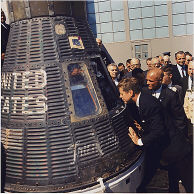
Kennedy was eager for the United States to lead the way in the space race. The Soviet Union was ahead of the United States in its knowledge of space exploration and Kennedy was determined that the U.S. could catch up. He said, "No nation which expects to be the leader of other nations can expect to stay behind in this race for space" and "We choose to go to the Moon and to do the other things, not because they are easy, but because they are hard". Kennedy asked Congress to approve more than twenty two billion dollars for Project Apollo, which had the goal of landing an American man on the Moon before the end of the decade. In 1969, six years after Kennedy's death, this goal was finally realized when Neil Armstrong and Buzz Aldrin became the first humans to land on the Moon.
Cabinet
| OFFICE | NAME | TERM |
| President | John F. Kennedy | 1961–1963 |
| Vice President | Lyndon B. Johnson | 1961–1963 |
| State | Dean Rusk | 1961–1963 |
| Treasury | C. Douglas Dillon | 1961–1963 |
| Defense | Robert S. McNamara | 1961–1963 |
| Justice | Robert F. Kennedy | 1961–1963 |
| Postmaster General | J. Edward Day | 1961–1963 |
| John A. Gronouski | 1963 | |
| Interior | Stewart L. Udall | 1961–1963 |
| Agriculture | Orville L. Freeman | 1961–1963 |
| Commerce | Luther H. Hodges | 1961–1963 |
| Labor | Arthur J. Goldberg | 1961–1962 |
| W. Willard Wirtz | 1962–1963 | |
| HEW | Abraham A. Ribicoff | 1961–1962 |
| Anthony J. Celebrezze | 1962–1963 | |
Supreme Court appointments
Kennedy appointed the following Justices to the Supreme Court of the United States:
- Byron Raymond White - 1962
- Arthur Joseph Goldberg - 1962
Image, social life and family
- See also: Kennedy political family
Both Kennedy and his wife "Jackie" were very young when compared to earlier presidents and first ladies, and were both extraordinarily popular in ways more common to pop singers and movie stars than politicians, influencing fashion trends and becoming the subjects of numerous photo spreads in popular magazines.
The Kennedys brought a new life and vigor to the atmosphere of the White House. They believed that the White House should be a place to celebrate American history, culture, and achievement and invited artists, writers, scientists, poets, musicians, actors, Nobel Prize winners and athletes to visit. Jacqueline Kennedy also gathered new art and furniture and eventually restored all the rooms in the White House.
The White House also seemed like a more fun, youthful place, because of the Kennedys' two young children, Caroline and John Jr. (who came to be known in the popular press, erroneously, as "John-John"). Outside the White House Lawn, the Kennedys established a pre-school, swimming pool, and tree house.
Behind the glamorous facade, the Kennedys also suffered many personal tragedies, most notably the death of their newborn son Patrick Bouvier Kennedy in August 1963.
Information revealed after John F. Kennedy's death leaves no doubt that he had many extramarital affairs while in office, including liaisons in the White House with some female staff and visitors. In his era, though, such issues were not considered fit for publication, and in Kennedy's case, they were never publicly discussed during his life, even though there were some public clues of an involvement with Marilyn Monroe, such as the manner in which she sang Happy Birthday Mr. President at his televised birthday party in May, 1962. In the years after his death, many liaisons were revealed, including one with Judith Campbell Exner , who was simultaneously involved with Chicago mob boss Sam Giancana.
The "charisma" Kennedy and his family projected posthumously led to the figurative designation of "Camelot" for his administration.
Assassination and aftermath
- Main article: John F. Kennedy assassination

President Kennedy was assassinated in Dallas, Texas, on Friday, November 22, 1963 at 12:30 pm CST while on a political trip through Texas.
Lee Harvey Oswald, arrested in a movie theater at 1:50 pm was charged at 7:00 pm for killing a Dallas policeman by "murder with malice", and also charged at 11:30 pm for the "murder" of the president (there being no charge of "assassination" of a president at that time). Oswald was himself fatally shot less than two days later in the basement of the Dallas police station by Jack Ruby, a Dallas nightclub owner with ties to the police, the mafia and organized crime, before Oswald could receive a court trial. Five days after Oswald was killed, President Lyndon B. Johnson created the Warren Commission, chaired by Chief Justice Earl Warren, to investigate the assassination. See John F. Kennedy assassination for further detailed facts and considerations surrounding President Kennedy's assassination.
Kennedy's life and the subsequent conspiracy theories surrounding his death have been the topic for many films, including Mark Lane's 1966 Rush to Judgment, ABC TV's 1983 mini series Kennedy, Nigel Turner's 1988, 1991, 1995, and 2003's continuing documentary The Men Who Killed Kennedy, Oliver Stone's 1991 JFK, the 1993 JFK: Reckless Youth (which looked at Kennedy's early years), and the 2000 Thirteen Days.
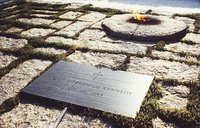
In November 2002 long-secret medical records were made public, revealing Kennedy's physical ailments were more severe than previously thought. He was in constant pain from fractured vertebrae despite multiple medications, in addition to suffering from severe digestive problems and Addison's disease. Kennedy received multiple injections of procaine before public events in order to appear healthy. Kennedy's spine was subject to osteoporosis triggered by injections of corticosteroids; this led to his using a brace to help support the crumbling vertebrae of his lower back. He was wearing such a brace (along with ace bandages wrapped around both upper thighs intertwined with his lower back) on the day of his assassination. After being hit for the first time, his body might otherwise have slumped downward into a position within the vehicle which would have protected him from further shots, however the brace may have held his body upright making his head an easier target.
On March 14, 1967 Kennedy's body was moved to a permanent burial place and memorial at Arlington National Cemetery.
As an honorary commemoration, Kennedy's portrait now appears on the United States half dollar coin. New York Idlewild International Airport was renamed John F. Kennedy International Airport on December 24, 1963 to honor his memory.
Kennedy, the youngest U.S. President ever elected, also died younger than any other president – at 46 years and 177 days. Kennedy is the only president people honor on the day of his death because it is burned in the memory of many all around the world old enough to remember. U.N. Ambassador Adlai Stevenson said of the assassination that "all of us...will bear the grief of his death until the day of ours."
Criticism
JFK is among the most popular former Presidents of the United States; however, a number of critics argue that his reputation is largely undeserved. While he was young and charismatic, he had little chance to achieve much during his presidency. The Civil Rights Act which he sent to Congress in 1963 was, at least in part, conceived by his brother and Attorney-General Robert F. Kennedy, and largely implemented by his successor, Lyndon Johnson, in 1964.
Kennedy's family was connected to the Labor Union movement, which was long connected to organized crime. ABC News aired a story in 1997 called Dangerous World: The Kennedy Years, narrated by Peter Jennings, that included electronically-altered interviews with people who said JFK's father, Joseph Kennedy, arranged for the Mafia to stuff the ballot boxes in Chicago, Kansas City, and Las Vegas — but other research has concluded that whatever fraud may have existed was not enough to change the outcome of the election. Noteworthy in this regard, Robert Kennedy's attempts to prosecute organized crime figures were among the most resolute to that date.
Kennedy's personal life has also attracted the ire of critics, some of whom argue that lapses in judgment in his personal life impacted his professional life. Many of these criticism stem from revelations about the extent to which the Kennedy family went to hide his serious, potentially life-threatening health issues from the voting public, his heavy medication regimen, his long history of extra-marital dalliances, and alleged, circuitous links to organized crime figures. Seymour Hersh's Dark Side of Camelot (1998) presents such a critical argument. Robert Dallek's An Unfinished Life (2003) is a more balanced biography, but contains much detail on JFK's health issues.
Another of Kennedy's critics is Noam Chomsky, whose book Rethinking Camelot: JFK, the Vietnam War, and US Political Culture (1993) presents an image of the Kennedy administration opposite to the one that lingers in mainstream memory. The book is a criticism of policy rather than his personal life, and explores information not usually presented about the 35th president.
Trivia
- Because of his early death at age forty-six, he was outlived by three of his predecessors, Herbert Hoover (1874-1964), Dwight D. Eisenhower (1890-1969) and Harry S. Truman (1884-1972), and four of his successors who were born before him, Lyndon B. Johnson (1908-1973), Richard Nixon (1913-1994), Gerald Ford (1913-) and Ronald Reagan (1911-2004).
- After his assassination, admirers began documenting similarities between Kennedy and Abraham Lincoln: seven letters in last name, Vice Presidents named Johnson, assassinated by a man who used all three names - who was in turn killed before trial. This led to the discovery that every President since Lincoln, elected in a year ending in 0 (Garfield 1880, McKinley 1900, Harding 1920, Roosevelt 1940) had died in office. When Ronald Reagan was elected in 1980, because of his advanced age, this supposed curse gained some new notoriety. In spite of an assassination attempt, age, and health issues, President Reagan broke the curse, living fifteen years after his Presidency ended and even becoming the longest lived President.
- Aldous Huxley and C.S. Lewis both died on the same day as him. But because of the assassination, their deaths received little media attention.
- John F. Kennedy was a member of the Knights of Columbus.
See also
- John F. Kennedy assassination
- Kennedy Compound
- John F. Kennedy Center for the Performing Arts
- John Fitzgerald Kennedy Library in Boston, Massachusetts
- Kennedy family
- U.S. presidential election, 1960
- History of the United States (1945–1964)
- Peace Corps
- John F. Kennedy Eternal Flame
- John F. Kennedy Memorial at Runnymede, England
- Kennedy Memorial Trust
- Whiz Kids
- Evelyn Lincoln, personal secretary to the President
- Kennedy Doctrine
- Lincoln/Kennedy Coincidences
External links
- Audio clips (http://vvl.lib.msu.edu/showfindingaid.cfm?findaidid=KennedyJF) of Kennedy's speeches and other commentary related to him
- Biography of John F. Kennedy (http://www.usa-presidents.info/kennedy.htm)
- Inaugural Address (http://www.yale.edu/lawweb/avalon/presiden/inaug/kennedy.htm)
- Medical History (http://www.doctorzebra.com/prez/t35.htm)
- Assassination of President Kennedy Encyclopaedia (http://www.spartacus.schoolnet.co.uk/JFKindex.htm)
- First State of the Union Address of JFK (http://www.usa-presidents.info/union/kennedy-1.html)
- Second State of the Union Address of JFK (http://www.usa-presidents.info/union/kennedy-2.html)
- Third State of the Union Address of JFK (http://www.usa-presidents.info/union/kennedy-3.html)
- American University Address (http://www.american.edu/media/speeches/Kennedy.htm)
- American Presidents: Life Portraits (http://www.americanpresidents.org/survey/)
- Radio Ceylon mourns the death of President John F.Kennedy (http://ivan_corea.tripod.com/radioceylon_jfkennedy)
History Clipart and Pictures
- Pictures of the US Presidents (http://classroomclipart.com/cgi-bin/kids/imageFolio.cgi?direct=History/United_States/Presidents)
- Clipart of American Presidents (http://classroomclipart.com/cgi-bin/kids/imageFolio.cgi?direct=Clipart/American_Presidents)
- Historical Pictures of the United States (http://classroomclipart.com/cgi-bin/kids/imageFolio.cgi?direct=History/United_States)
- Pictures of the American Revolution (http://classroomclipart.com/cgi-bin/kids/imageFolio.cgi?direct=History/United_States/American_Revolution)
- Civil Rights Pictures (http://classroomclipart.com/cgi-bin/kids/imageFolio.cgi?direct=History/United_States/Civil_Rights)
- Civil War Images (http://classroomclipart.com/cgi-bin/kids/imageFolio.cgi?direct=History/United_States/Civil_War)
- Pictures of Colonial America (http://classroomclipart.com/cgi-bin/kids/imageFolio.cgi?direct=History/United_States/Colonial_America)
- Historical US Illustrations (http://classroomclipart.com/cgi-bin/kids/imageFolio.cgi?direct=History/United_States/Illustrations)
- World War II Pictures (http://classroomclipart.com/cgi-bin/kids/imageFolio.cgi?direct=History/United_States/World_War_II)
- Pictures of Historical People (http://classroomclipart.com/cgi-bin/kids/imageFolio.cgi?direct=History/United_States/People)


